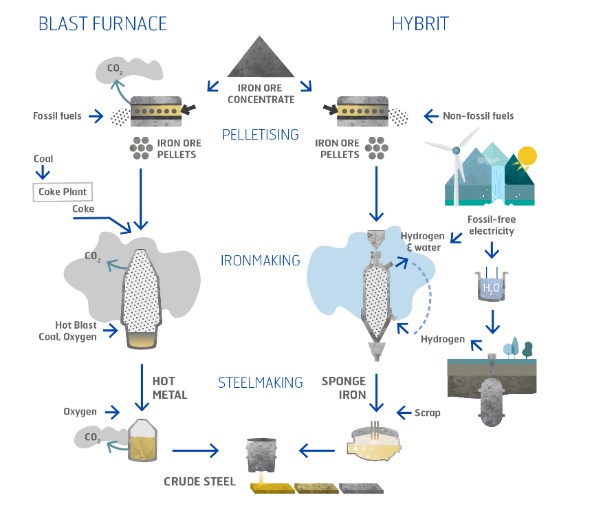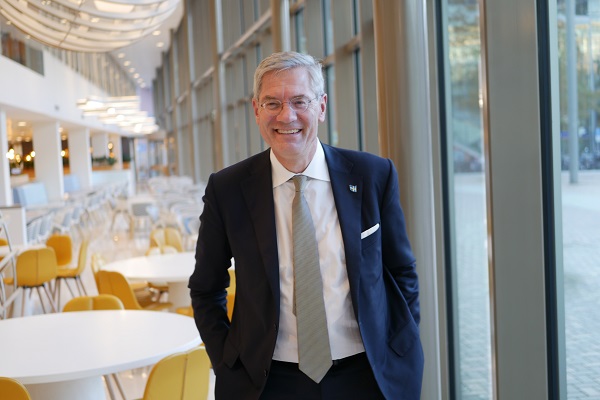If notorious CO2 emitters such as the steel and cement industries manage to produce fossil-free, then also other sectors could manage. The message Vattenfall CEO Magnus Hall is spreading is hopeful.
The story of Vattenfall literally starts at the Swedish Falls. At the beginning of the twentieth century, the state-owned company was already using hydropower to generate electricity. Later, seven nuclear power plants were added and after the wave of European liberalization, expansion began to Denmark, Germany, Poland, England, the Netherlands, France and Norway. The shifts brought about by the energy transition were followed by a hectic period. The nuclear cradle forced the company to dismantle its German nuclear power plants and Dutch investments were also under pressure due to overcapacity in the electricity market.
Wind energy
Vattenfall’s course is increasingly shifting towards sustainable, renewable sources, of which wind energy is a growing part. Brown and coal-fired power stations no longer fit into this line and the energy giant is gradually saying goodbye to its fossil power stations. The final achievement was the closure of the Hemweg power station in Amsterdam.
Hall sees it as the last bump towards a completely fossil-free energy supply. In Sweden, the energy sector was already fossil-free and decarbonisation focuses on transport and industry. In other countries where we are active, however, fossil power plants are still in operation. The power stations we still operate are the most efficient of their kind. Power stations such as the German 1.7 gigawatt Moorburg cogeneration plant will be badly needed to support the energy transition. But even that will eventually have to make way for truly sustainable assets. In addition to hydropower, in our view this is mainly onshore and offshore wind.
Even the International Energy Agency, which is known for its conservative stance towards renewables, holds great growth opportunities for the European wind energy sector. We are therefore doing everything we can to make full use of that potential. The subsidy-less investment in Hollandse Kust 1 to 4 is also a milestone for us and there are still large investments to come. We are building the country’s largest wind farm in the United Kingdom and Denmark, among others, but also in Sweden. We need to stay in shape in order to stay in competition in this very fast developing market. But we’re confident that we can.’
Electrification
Where this sustainable electricity should end up is also clear to Hall. Electrification of the transport sector is perhaps the simplest step. Certainly public transport can switch to electric buses fairly quickly. But electrification of the private car fleet is also going faster than we thought a few years ago. In Norway, more electric cars have been sold than fossil-powered in the past month. In the Netherlands, Tesla is at the top with the number of cars sold. Our task is to facilitate an infrastructure that links sustainable energy to electric transport. And the better we do that, the better that is for the electricity system. We are opening up a gigantic storage medium for wind and solar energy’.
Vattenfall recently announced that the charging stations in Amsterdam will provide extra power if there is a surplus of solar energy. As a result, electric cars relieve the burden on the grid, which in turn can dampen investments for grid manager Liander.
Hall also sees plenty of opportunities for domestic heating with electric heat pumps, or in some cases electric boilers. Whether this is done individually or in the form of district heating depends on environmental factors. After the commotion surrounding the biomass power plant in Diemen, Vattenfall feels encouraged to continue the transition to sustainable sources of district heating as well as the electric path.
Durable steel
This electric road certainly also applies to industry, although renewable electricity can also be used here to split water. Hall: ‘We are already investing in electrolyzers. The combination with industrial users strengthens the business case for hydrogen. For example with chemistry, which is also looking for alternatives to fossil hydrocarbons. The combination of captured carbon dioxide with hydrogen offers opportunities for many valuable products.
We have already taken up the challenge of fossil-freeing steel production. Together with steel producer SSAB and mining company LKAB, we are investigating in the Hybrit project whether we can use hydrogen as a substitute for coke and coal in the blast furnaces. Coke and coal are normally fired at high temperatures to melt the iron ore. This is also possible by directly reducing iron ore pellets with hydrogen. LKAB supplies the pellets and Vattenfall the green hydrogen. We expect to be able to produce the first steel using this process as early as 2035.
The Hybrit project has the full attention of the United Nations because it offers a potential alternative to one of the largest CO2 emitters in the world: the steel industry. We are also building an underground storage facility on the SSAB site. This will enable us to absorb excess wind power and at the same time help the steel industry meet one of its greatest challenges’.

Cement
The cement industry has the same dubious reputation as CO2 emission champion. Vattenfall works together with Cementproducer Cementa to electrify the production of cement clinker. The cement industry has so far used coal to heat the raw materials to over 1400 degrees Celsius.
Hall: ‘Electrification of cement production via plasma technology is possible. Cementa’s production site could even be directly linked to the expansion of a wind farm near the factory. So we make sure that no fossil fuels have to be used to heat the raw materials. CO2 is still released during the process, but this can be captured fairly easily. This highly concentrated stream can be used again as a raw material for the chemical industry, for example, or stored underground if necessary’.
Alliances
The role that Vattenfall plays in these developments is not fixed for Hall. The energy transition is so complex that new alliances are needed to make a real success. Sometimes we are leading a project, but other times we are a smaller part of the chain. We can and want to invest in sustainable assets ourselves, but sometimes a project requires other contributions. We are good at power generation, conversion, transport, storage and trading. We are happy to use that knowledge to support the industry in its challenges. For example, we are concluding more and more power purchase agreements (ppa, ed.) with industrial users. In this way, we link the production of a wind farm directly to the electricity consumption of parties such as Microsoft. In this way, Microsoft’s data centres will be assured of sustainable energy in the coming years, while we will be given room to invest more in sustainable assets. An additional advantage is that in the coming years the customer will know how much money he is spending on his sustainable electricity’.
Chain responsibility
Although many of the examples Hall mentions are still in the early stages, the Vattenfall CEO sees that the industry is changing rapidly. Public opinion is steering the major consumer brands towards sustainable entrepreneurship. And they in turn ask their chain to support them in this. Of course there are uncertainties about which technology, raw material or energy form is the best choice, but companies will have to choose. Our choice for electrification may also be a gamble, but it is a very safe one. We have the technology to do this and if companies and governments really dare to make choices, the money we need is available. In the coming years I expect an acceleration in the route we have taken. Electrification of the transport sector is already gaining momentum, the industry is still waiting, but can also make great strides.
As sustainable generating capacity increases, this improves the business case for industry. Not only because it lowers the prices of sustainably generated electricity, but also because it can play an active role in balancing the energy system. The energy sector and industry can reinforce each other and will therefore have to engage in more dialogue about their joint role in the energy transition’.
No tax
It is also clear to Hall what Vattenfall and its partners need from the government: continuation of the European Emissions Trading System (EU ETS, ed.). The beauty of the European ETS is that it does not prescribe technology,’ says Hall. By stimulating or excluding technologies, you disrupt market forces. The best thing, of course, is to enforce a fair price for CO2 emissions worldwide. But if we can already get the European ETS to a level where renewable energy competes with fossil variants, the market can do its job. We have to do this as one. It is not convenient for individual Member States to introduce their own additional CO2 taxes because they have greater ambitions. The Dutch desire to accelerate the energy transition is admirable. But when it comes to CO2 pricing, the Netherlands threatens to be out of step with the rest of the EU. It is better to tackle this together, so that ecology and economy remain in balance’.




